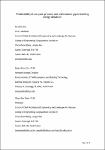Predictability of occupant presence and performance gap in building energy simulation
| dc.contributor.author | Ahn, K-U | |
| dc.contributor.author | Kim, D-W | |
| dc.contributor.author | Park, C-S | |
| dc.contributor.author | de Wilde, Pieter | |
| dc.date.accessioned | 2017-12-12T20:38:46Z | |
| dc.date.issued | 2017-05-12 | |
| dc.identifier.issn | 0306-2619 | |
| dc.identifier.issn | 1872-9118 | |
| dc.identifier.uri | http://hdl.handle.net/10026.1/10422 | |
| dc.description | File replaced (docx to pdf) on 25.4.23 by NK (LDS) | |
| dc.description.abstract |
Occupant behavior is regarded as one of the major factors contributing to the discrepancy between simulation prediction and real energy use. Over the past several decades, occupants have been represented as fixed profiles of occupant presence in building energy simulation tools. Recently, stochastic models have been introduced to account for dynamic occupant presence. This stochastic approach is based on the premise that occupant presence can be described by empirical and probabilistic transition rules, e.g. Markov Chain. This paper presents evidence that occupant presence in some rooms and buildings follows a “random walk” pattern. In other words, occupant presence in certain types of buildings cannot be predicted stochastically. In this study, occupants’ presence in two laboratories and three reading rooms at two universities was monitored. The hypothesis of the random walk pattern was tested using the Normalized Cumulative Periodogram (NCP) method. Based on a series of six experiments, it is shown that each occupant's presence in the five locations follows a random walk pattern. Three different occupant models (fixed ASHRAE model, Markov Chain model, and Random Walk model) were applied in EnergyPlus simulation runs. The adjusted R2 for three experiments between the fixed AHSRAE model and the random walk model, and between the Markov chain model and the random walk model are 0.54, 0.02, 0.01 and 0.86, 0.19, 0.41, respectively. This does not negate the need for the fixed ASHRAE model or the MC model. Rather, this signifies that, for a certain type of building, another occupant presence model should be introduced, e.g. the RW Model. | |
| dc.format.extent | 1639-1652 | |
| dc.language | en | |
| dc.language.iso | en | |
| dc.publisher | Elsevier BV | |
| dc.subject | Occupant presence | |
| dc.subject | Occupant behavior | |
| dc.subject | Random walk | |
| dc.subject | Energy prediction | |
| dc.subject | Performance gap | |
| dc.subject | Normalized cumulative periodogram | |
| dc.title | Predictability of occupant presence and performance gap in building energy simulation | |
| dc.type | journal-article | |
| dc.type | Journal Article | |
| plymouth.author-url | https://www.webofscience.com/api/gateway?GWVersion=2&SrcApp=PARTNER_APP&SrcAuth=LinksAMR&KeyUT=WOS:000416300400121&DestLinkType=FullRecord&DestApp=ALL_WOS&UsrCustomerID=11bb513d99f797142bcfeffcc58ea008 | |
| plymouth.volume | 208 | |
| plymouth.publication-status | Published | |
| plymouth.journal | Applied Energy | |
| dc.identifier.doi | 10.1016/j.apenergy.2017.04.083 | |
| plymouth.organisational-group | /Plymouth | |
| plymouth.organisational-group | /Plymouth/Faculty of Arts, Humanities and Business | |
| plymouth.organisational-group | /Plymouth/REF 2021 Researchers by UoA | |
| plymouth.organisational-group | /Plymouth/REF 2021 Researchers by UoA/UoA13 Architecture, Built Environment and Planning | |
| dcterms.dateAccepted | 2017-04-26 | |
| dc.rights.embargodate | 2018-5-12 | |
| dc.identifier.eissn | 1872-9118 | |
| dc.rights.embargoperiod | Not known | |
| rioxxterms.versionofrecord | 10.1016/j.apenergy.2017.04.083 | |
| rioxxterms.licenseref.uri | http://www.rioxx.net/licenses/all-rights-reserved | |
| rioxxterms.licenseref.startdate | 2017-05-12 | |
| rioxxterms.type | Journal Article/Review |


